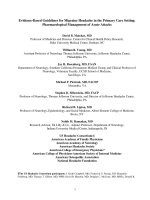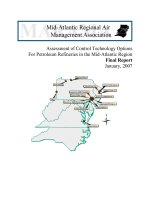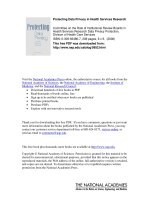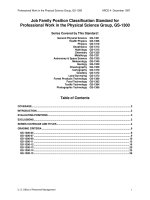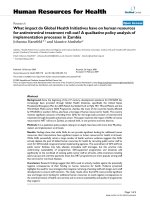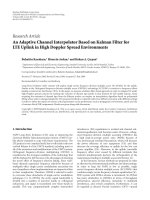Health services research on endoscopic surveillance for gastric cancer in the singapore chinese population experience of the gastric cancer epidemiology clinical and genetic program
Bạn đang xem bản rút gọn của tài liệu. Xem và tải ngay bản đầy đủ của tài liệu tại đây (3.55 MB, 201 trang )
HEALTH SERVICES RESEARCH ON
ENDOSCOPIC SURVEILLANCE FOR GASTRIC CANCER
IN THE SINGAPORE CHINESE POPULATION
– Experiences of the Gastric Cancer Epidemiology Clinical & Genetic Programme
By
ZHOU HUIJUN
(M.B.B.S., MSc in Clinical Science)
A THESIS SUBMITTED FOR
THE DEGREE OF DOCTOR OF PHILOSOPHY
SAW SWEE HOCK SCHOOL OF PUBLIC HEALTH
NATIONAL UNIVERSITY OF SINGAPORE
2013i
ACKNOWLEDGEMENTS
I would like to express my sincere thanks and gratitude to the following people without whom my
PhD and this thesis would not have been possible.
First and foremost, I would like to express my heart-felt appreciation to Prof. Lee Hin Peng for
his inspiring guidance and insightful advice throughout my PhD study.
I am greatly indebted to Prof. Yeoh Khay Guan for his expert guidance in gastric cancer
surveillance and his generosity for financial support.
I owe a great deal to Prof. Li Shu Chuen for his expert guidance in health services research and
career development.
I am deeply grateful to my best friend Dr. Nasheen Naidoo for refining my manuscripts with his
excellent academic writing skills and his unfailing encouragements.
I am deeply grateful to Prof. Dan Yock Young for his valuable instructions in Markov model
construction and sincere support in my PhD pursuit.
Special thanks go to Prof. Jimmy So Bok Yan and Prof. Yong Wei Peng for referring their
patients to my study
Thankful to team members of the Gastric Cancer Epidemiology Clinical & Genetic Program for
their coordination and assistance in data collection
Last but not least, to School of Public Health for providing me with this opportunity to further my
academic pursuit in the field of health services research.
ii
TABLE OF CONTENTS
ACKNOWLEDGEMENTS i
TABLE OF CONTENTS ii
SUMMARY vi
LIST OF TABLES x
LIST OF FIGURES xii
LIST OF ABBREVIATIONS xvi
CHAPTER I: GASTRIC CANCER BURDEN 1
1.1 Gastric Cancer - Definition and Classification 1
1.1.1 Gastric cancer definition 1
1.1.2 Gastric cancer staging and histological classification 2
1.2 Global Burden of Gastric Cancer 7
1.2.1 Gastric cancer incidence 7
1.2.2 Gastric cancer mortality 8
1.3 Singapore Burden of Gastric Cancer 9
1.3.1 Gastric cancer incidence 9
1.3.2 Gastric cancer mortality 11
1.4 Risk Factors for Gastric Cancer Development 12
1.5 Clinical Management and Clinical Outcomes of Gastric Cancer 14
1.5.1 Gastric cancer treatment 14
1.5.2 Clinical outcome 1 - survival rate 15
1.5.3 Clinical outcome 2 - quality of life 16
CHAPTER II: GASTRIC CANCER PREVENTION 18
2.1 Gastric Cancer Carcinogenesis 18
2.2 Chemoprevention- H. pylori Eradication 20
2.2.1 Consequence of H. pylori infection 20
2.2.2 Effectiveness and cost-effectiveness of H. pylori eradication 21
2.2.3 Concerns about implementing population-based H. pylori screening 22
2.3 Secondary Prevention – Gastric Cancer Screening or Surveillance 22
2.3.1 Theoretical basis for secondary prevention of gastric cancer 23
2.3.2 Effectiveness and cost-effectiveness of gastric cancer screening or surveillance 24
iii
2.3.3 Concerns about secondary prevention 25
2.4 Existing National Screening Programs 27
2.4.1 Japan 27
2.4.2 South Korea 27
2.5 Summary 28
CHAPTER III: COST OF DELIVERING GASTRIC CANCER SURVEILLANCE 30
3.1 Background 30
3.2 Methods 32
3.2.1 General approach 32
3.2.2 Service mix of the GCEP program 32
3.2.3 Study site, period and sample 32
3.2.4 Resource quantification and costing 33
3.2.5 Outcomes 36
3.2.6 Statistical analysis 37
3.3 Results 38
3.4 Discussions 44
3.5 Conclusion 49
CHAPTER IV: QUALITY OF LIFE OF PATIENTS WITH GASTRIC CANCER 50
4.1 Introduction 50
4.2 Method and Materials 51
4.2.1 Study sample 51
4.2.2 Quality of life instruments 54
4.2.3 Statistical analysis 56
4.3 Results 58
4.3.1 Ceiling effect and the reliability index 59
4.3.2 Sensitivity 61
4.4 Discussion 63
4.5 Conclusion 67
CHAPTER V: COST EFFECTIVENESS ANALYSIS - MARKOV MODEL
CONSTRUCTION 68
5.1 Gastric Cancer Prevention – From Mass Screening to Focused Surveillance 68
5.2 Research Frame of Cost-Effectiveness Analysis Endoscopic Surveillance 70
iv
5.2.1 Target population 70
5.2.2 Endoscopy/Biopsy protocol 70
5.2.3 Strategies in consideration ………………………………………………….71
5.2.4 Determination of willingness-to-pay 73
5.3 Markov Model Development 73
5.3.1 Thought experiment before model development 74
5.3.2 Building Markov model with TreeAge software 77
5.4 Expansion and Population of the Markov Tree 81
5.4.1 Gastric Cancer Development in the Target Population 82
5.4.2 Gastric cancer survival 91
5.4.3 Death 94
5.4.4 Early detection by screening and surveillance 99
5.4.5 Cost estimation 100
5.4.6 Utility 103
CHAPTER VI. COST EFFECTIVENESS ANALYSIS - MODEL VALIDATION &
PROJECTIONS 105
6.1 Internal Validation of the Markov Model 105
6.1.1 Validation of gastric cancer incidence 106
6.1.2 Validation of all-cause mortality 107
6.2 Model Outputs in the Base-Case Scenario 108
6.2.1 Cohort analysis 108
6.2.2 Cost-effectiveness analysis 109
6.2.3 Heterogeneity in cost effectiveness 110
6.3 Deterministic Sensitivity Analysis 112
6.3.1 Discount Rate 114
6.3.2 Age of starting OGD follow-up 115
6.3.3 Willingness-To-Pay 116
6.3.4 Odds ratio 117
6.3.5 Program cost 118
6.3.6 Utility of gastric cancer stage 1 119
6.3.7 Cost of follow-up OGD 120
6.3.8 Cost of baseline OGD 121
6.3.9 Prevalence of precancerous gastric lesions 122
v
6.4 Probabilistic Sensitivity Analysis 123
6.4.1 Utility of gastric cancer patients at each clinical stage 124
6.4.2 Distributions of gastric cancer stage 128
6.4.3 Odds ratio 131
6.4.4 Prevalence of precancerous lesions 132
6.4.5 Age of starting OGD intervention 133
6.4.6 Overall uncertainty in decision making 135
CHAPTER VII: COST-EFFECTIVENESS ANALYSIS -CONCLUSION AND FUTURE
WORK 136
7.1 Overall Assessment of Endoscopic Surveillance for Gastric Cancer 136
7.2 Heterogeneity of Endoscopic Surveillance 137
7.3 Influential Factors for Program Implementation 137
7.4 Robustness of the Findings 139
7.5 Strength and Limitation 140
7.6 Conclusion 141
7.7 Future Work 141
7.7.1 Cost of illness of gastric cancer 141
7.7.2 In-hospital mortality of a gastric cancer patient 142
7.7.3 Prevalence of precancerous lesions 142
7.7.4 A model based on a dynamic cohort 142
7.7.5 An empirical model based on GCEP 143
REFERENCES 144
PUBLICATIONS 159
APPPENDICES 160
vi
SUMMARY
Gastric cancer is largely a fatal disease associated with high incidence and mortality in most
Asian populations where it imposes a huge disease and economic burden on the society. Given
that the efficacy of gastric cancer treatment is still unsatisfactory, efforts have been directed at its
prevention. Presently secondary prevention measures aiming for early detection, namely
screening and surveillance, have assumed an increasingly important role for gastric cancer control.
Mass screening targets the asymptomatic subjects in the general population at high risk of gastric
cancer. Surveillance focuses on the people with precancerous lesions who are therefore already in
the process of gastric cancer development. Studies have demonstrated that both screening and
surveillance are effective in detecting the malignancy at an earlier stage and consequently
achieving longer patient survival. However, for public health practice to translate these research
findings into health benefits, more information is needed to investigate the cost of illness, clinical
outcome and ultimately cost-effectiveness ratio. These studies belong to health services research
(HSR).
This PhD project was undertaken to conduct HSR studies on the secondary prevention of gastric
cancer, particularly endoscopic surveillance. Besides its value as an academic pursuit, this PhD
project aims to provide scientific evidence to address the issues regarding implementing an
endoscopic surveillance program for gastric cancer in the Singapore Chinese population. The
cost-effectiveness data may also help health authorities to make an informed decision on the
worth of investing in such a public health program for Singapore.
vii
Nested within the Gastric Cancer Epidemiology, Clinical and Genetics Program (GCEP), three
studies were designed for this project. Each study has value in its own right and at the same time,
they together form a coherent series to answer the overriding question of this project: Is
endoscopic surveillance for gastric cancer cost-effective in the Singapore healthcare system? For
the benefit of readers and reviewers, the thesis is organized into seven chapters as follows.
Chapter I introduces basic clinical and epidemiological knowledge about gastric cancer, and two
commonly used clinical outcomes in cancer research, namely, survival rate and quality of life.
Readers can catch an overview of gastric cancer. This chapter aims to convey the message that
gastric cancer is of major public health significance in Singapore and worldwide.
Chapter II introduces the key definitions and concepts regarding gastric cancer prevention. The
natural history of gastric cancer and the theory of secondary prevention are explained. I also
summarize the current state of gastric cancer prevention highlighted by different studies.
Chapter III presents the first study of this project which is a cost of illness study based on
empirical data from the GCEP in delivering endoscopic surveillance. Unlike a conventional cost
of illness study which covers the clinical phase starting from diagnosis to post-diagnosis
treatment until the patient’s death, our study sheds light on the cost increment before the
diagnosis, an area rarely touched to date. As a stand-alone cost analysis, we elucidated the
mechanisms underlying the temporal trend of cost generation. Health policy makers can use this
information in the planning of a long-term program. To enhance the coherence of this project,
results have been directly used in the final model of the cost-effectiveness analysis.
viii
Chapter IV presents the second study which is a quality of life study in Chinese patients with
gastric cancer. We validated a gastric cancer specific quality of life instrument called Functional
Assessment of Cancer Therapy-Gastric module (FACT-Ga). This validation study paves the way
for future quality of life research for gastric cancer in Chinese populations. At the same time, the
scores of the European Quality of Life Five Dimensions (EQ-5D) instrument derived by this
study have been inputted to reflect the utilities of gastric cancer patients in the final cost
effectiveness analysis.
The third study, a cost-effectiveness analysis using the Markov model, is presented in the
subsequent three chapters.
Chapter V gives a detailed description about how the Markov model was built using TreeAge
software. To highlight transparency as one of the key criteria for model validity, I have explained
step by step the clinical assumptions and pros and cons of the data selected. Readers are able to
have a clear picture about the model construction process from a simple diagram to a complicated
Markov model.
Chapter VI presents the cost-effectiveness ratio and its heterogeneity at base case analysis. The
input parameters are examined extensively by deterministic and probabilistic sensitivity analysis.
Results are presented for the parameters with significant impact on net health benefit or
probability of being cost-effective.
Chapter VII discusses the findings of the Markov model from the perspective of the healthcare
system. The cost-effectiveness of 2-yearly endoscopic screening, annual endoscopic surveillance
ix
and no endoscopic intervention were compared. The model recommended surveillance to be the
cost-effective strategy in prevention of gastric cancer in Singapore Chinese. Several parameters
are identified as influential factors for establishing a successful endoscopic surveillance program.
Future research to improve predictability and precision of the current model is suggested.
x
LIST OF TABLES
Table 1-1. Subsite distribution of gastric cancer in the stomach (2003-2007) 2
Table 1-2. TNM staging system for gastric cancer 4
Table 1-3. Clinical staging system for gastric cancer 6
Table 1-4. Basic statistics of gastric cancer in Singaporean Chinese (2003 – 2007) 10
Table 1-5. 5-year survival rates of Singapore Chinese (%) (1998-2002) 16
Table 1-6. Utility of gastric cancer patients used in cost-effectiveness studies 17
Table 3-1. Cost components and cost estimation of the GCEP (2004-2010) 35
Table 3-2. Yearly patient volume of GCEP (2004-2010) 38
Table 3-3. Characteristics of the study cohort and sample 38
Table 3-4. GEE models fitting temporal trends of cost indices and comparison of subgroup trends.
43
Table 4-1. Utility weights for EQ-5D domains 56
Table 4-2. Demographic and clinical characteristics of the sample 58
Table 4-3: Score distributions, ceiling effect, reliability and item-scale convergence of the FACT-
Ga and EQ-5D 60
Table 4-4. Sensitivity of FACT-Ga scores and EQ-5D utility to clinical severity 60
Table 4-5. Multitrait-multimethod correlations matrix between EQ-5D domains and FACT-Ga
subscales 62
Table 5-1. Endoscopy frequency recommended for endoscopic surveillance for gastric cancer 69
Table 5-2. Gastric cancer incidence reported by the Singapore Cancer Registry (1/100,000) 84
Table 5-3. Gastric cancer incidence by age and gender in the Markov model (1/100,000) 85
Table 5-4. Annual probability of gastric cancer survival by clinical stage (%) 93
Table 5-5. Probability of dying at each age of the Singapore Chinese population 96
Table 5-6. Probability composition of gastric cancer patients surviving through a given year 98
Table 5-7. Pattern of death in gastric cancer patients (%) 99
xi
Table 5-8. Operational cost for a screening or surveillance program 101
Table 5-9. Algorithm of stage specific gastric cancer treatment 102
Table 5-10. Diagnostic cost and treatment cost by clinical stage 102
Table 5-11. Stage-specific utility of gastric cancer patients 104
Table 6-1. Reduction in gastric cancer related death by the surveillance and screening strategies
108
Table 6-2. Heterogeneity of the three strategies by age and gender 111
Table 6-3. Parameters impactful on net health benefit of surveillance strategy identified by
sensitivity analysis 113
Table 6-4. Distributions assigned to parameters in probabilistic sensitivity analysis 123
Table 6-5. Population size by age and gender (1000) 134
xii
LIST OF FIGURES
Figure 1-1. Anatomy of the stomach 1
Figure 1-2. Histological layers of stomach wall 3
Figure 1-3: Geographic distribution of gastric cancer incidence Rate 8
Figure 1-4: Geographic distribution of gastric cancer mortality 9
Figure 1-5. Age specific gastric cancer incidence by sex 10
Figure 1-6. Declining trends in gastric cancer mortality and incidence for males 11
Figure 1-7. Declining trends in gastric cancer mortality and incidence for females 12
Figure 2-1. Carcinogenesis for Gastric Cancer 19
Figure 2-2. Clinical consequences of H. pylori infection 20
Figure 2-3. Natural history of a disease 23
Figure 3-1: Phases and time frame of the GCEP 33
Figure 3-2. Cost Structure of the GCEP 34
Figure 3-3. Temporal trends (2004-2010) of cost indices for the whole sample. 39
Figure 3-4. Temporal trends (2004-2010) of cost indices for the age subgroups. 40
Figure 3-5. Temporal trends (2004-2010) of cost indices for the gender subgroups. 41
Figure 3-6. Temporal trends (2004-2010) of cost indices for the risk subgroups. 42
Figure 4-1. Sampling Frame of quality of life study 53
Figure 4-2. Subject recruitment process 54
Figure 4-3. Factor structure of FACT-G 55
Figure 4-4. Factor structure of FACT-Ga 55
Figure 5-1. Biopsy sites during endoscopy examination in screening and surveillance 71
Figure 5-2. Overview of the surveillance strategy 73
Figure 5-3. Overview of clinical pathway of target population developing gastric cancer 74
xiii
Figure 5-4. Overview of clinical pathway of present situation without gastric cancer prevention
76
Figure 5-5. Expected effect of stage-shift by gastric cancer prevention programs 77
Figure 5-6. Basic TreeAge tree comparing screening, surveillance and no OGD intervention 77
Figure 5-7. Markov Model for the no OGD intervention strategy 78
Figure 5-8. Markov Model for the screening strategy 79
Figure 5-9. Markov Model for the surveillance strategy 80
Figure 5-10. Gastric cancer development in the general population with no OGD intervention 83
Figure 5-11. Gastric cancer detected during years without follow-up OGD 86
Figure 5-12. Gastric Cancer detected by screening OGD 86
Figure 5-13. Gastric cancer development at baseline of the general population 88
Figure 5-14. Gastric cancer development in the low risk cohort 90
Figure 5-15. Gastric cancer development in the high risk cohort 91
Figure 5-16. Gastric cancer diagnosis and treatment with simulation of in-hospital mortality 92
Figure 5-17. Gastric cancer diagnosis and treatment without simulation of in-hospital mortality 92
Figure 5-18. Stage specific gastric cancer survival 94
Figure 5-19. Death states in the Markov model 94
Figure 5-20. Co-mortality of the target population 95
Figure 5-21. Death for other reasons of GC patients 97
Figure 5-22. Stage distribution of gastric cancer patients diagnosed under usual care 99
Figure 5-23. Stage distribution of gastric cancer patients detected by follow-up OGD 100
Figure 5-24. Cost assignment in Markov trees 103
Figure 6-1. Age-specific gastric cancer incidence of Singapore Chinese 106
Figure 6-2. Age-specific all-cause mortality of Singapore Chinese (original vs. model estimates)
107
Figure 6-3. Comparing the cost effectiveness of no OGD intervention, 109
Figure 6-4. Net Health Benefit variation across the range of the discount rate 114
xiv
Figure 6-5. Net Health Benefit variation across the range of age starting follow-up 115
Figure 6-6. Net Health Benefit variation across the range of willingness-to-pay 116
Figure 6-7. Net Health Benefit variation across the range of odds ratio of high risk subjects in the
surveillance strategy 117
Figure 6-8. Net Health Benefit variation across the range of proportion of program cost of
operational cost 118
Figure 6-9. NHB variation across the range of utility of Stage 1 gastric cancer patients 119
Figure 6-10. Net Health Benefit variation across the range of follow-up OGD cost 120
Figure 6-11. Net Health Benefit variation across the range of baseline OGD cost of the
surveillance strategy 121
Figure 6-12: Net Health Benefit variation across the range of prevalence of gastric precancerous
lesions 122
Figure 6-13. Simulated Gamma (310, 352) of the utility of Stage 1 patients 124
Figure 6-14. Simulated Gamma (151, 176) of the utility of Stage 2 patients 125
Figure 6-15. Simulated Gamma (60, 77) of the utility of Stage 3 patients 125
Figure 6-16. Simulated Gamma (72, 106) of the utility of Stage 4 patients 125
Figure 6-17. Probability of being cost-effective of the three strategies when accounting for
uncertainties surrounding the utility of Stage 2 patients 126
Figure 6-18. Probability of being cost-effective of the three strategies when accounting for
uncertainties surrounding the utility of Stage 3 patients 127
Figure 6-19. Probability of being cost-effective of three strategies when accounting for
uncertainties surrounding the utility of Stage 4 patients 127
Figure 6-20. Probability of being cost-effective of the three strategies when accounting for
uncertainties surrounding the utility of Stage 4 patients 128
Figure 6-21. Simulated input distribution representing the proportion of Stage 1 cases among
gastric cancer patients diagnosed under usual care 129
Figure 6-22. Simulated input distribution representing the proportion of Stage 1 cases among the
gastric cancer cohort detected by follow-up endoscopy 129
Figure 6-23. Probability of being cost-effective of three strategies when accounting for
uncertainties surrounding stage compositions of gastric cancer cohort 130
xv
Figure 6-24. Probability of being cost-effective for the three strategies when accounting for
uncertainties surrounding the stage composition of gastric cancer cohort 130
Figure 6-25. Simulated input distribution representing the odds ratio of high risk subjects in the
surveillance strategy 131
Figure 6-26. Probability of being cost-effective for the three strategies given uncertainties
surrounding the odds ratio 132
Figure 6-27. Simulated input distribution of prevalence of precancerous lesions 132
Figure 6-28. Probability of being cost-effective of the three strategies when accounting for
uncertainties surrounding prevalence of precancerous lesions. 133
Figure 6-29. Probability of being cost-effective for the three strategies given the age variation
among individuals of the target population 134
Figure 6-30. Probability of being cost-effective of the three strategies accounting for uncertainties
jointly contributed by nine parameters 135
xvi
LIST OF ABBREVIATIONS
ASIR: Age Standardized Incidence Rate
ASMR: Age Standardized Mortality Rate
ASRS: Age Standardized Relative Survival
CI: Confidence Interval
EGC: Early Gastric Cancer
EQ-5D: European Quality of Life Questionnaire- 5 Dimensions
FACT: Functional Assessment of Cancer Treatment
FACT-Ga: Functional Assessment of Cancer Treatment – Gastric
PWB: Physical Well-Being
EWB: Emotional Well-Being
SWB: Social Well-Being
FWB: Functional Well-Being
GCS: gastric cancer subscale
GC: Gastric Cancer
GCEP: Gastric Cancer Epidemiology Clinical & Genetic Program
GEE: Generalized Estimation Equation
H. pylori: Helicobacter Pylori
ICER: Incremental Cost-Effectiveness Ratio
NHB: Net Health Benefit
xvii
NUH: National University Hospital
OGD: Oesophago-Gastro-Deuodenoscopy
OR: Odds Ratio
PSA: Probabilistic Sensitivity Analysis
QALY: Quality Adjusted Life Year
QoL: Quality of Life
TNM System: Tumor Node Metastasis System
WTP: Willingness-To-Pay
1
CHAPTER I: GASTRIC CANCER BURDEN
1.1 Gastric Cancer - Definition and Classification
1.1.1 Gastric cancer definition
Gastric cancer (GC) refers to cancerous malignancy arising from any part of the stomach. In the
literature and clinical practice, the term GC does not refer to a single disease, but rather different
cancerous diseases affecting a single organ. Although GC is a heterogeneous disease covering
lymphoma, leiomyosarcoma, carcinoid, adenocarcinoma and squamous cell carcinoma, the most
frequently encountered histological type is mucosal adenocarcinoma which comprises more than 90%
of all GC cases worldwide (Forman and Burley 2006) and locally in Singapore (Singapore Cancer
Registry Committee 2010). Therefore, GC refers to the adenocarcinoma most of time in this thesis.
Figure 1-1. Anatomy of the stomach
The stomach is arbitrarily divided into five anatomical parts (Figure 1-1) labeled from proximal to
distal ends as cardia, fundus, body, pylorus and antrum. These labels help us locate and describe GC
lesions. The sites where GC occurs are also relevant to histological type and thus prognosis of patients.
Table 1-1 summarizes the subsite distribution of GC in Singapore.
2
Table 1-1. Subsite distribution of gastric cancer in the stomach (2003-2007)
Subsite
Male
Female
Cardia
249
116
Pylorus
72
35
Antrum
268
187
Fundus
19
13
Body
77
61
Body (less curvature)
124
80
Body (greater curvature)
42
34
Other
68
29
Not otherwise specified
456
330
(Singapore Cancer Registry 2011)
1.1.2 Gastric cancer staging and histological classification
Cancer staging is a critical step in clinical management and cancer-based public health programs. The
stage of a cancer patient measures the extent of disease spread and is related to treatment protocol,
cancer progression and future prognosis.
1.1.2.1 TNM staging system for gastric cancer
Like most solid tumors, GC Stage is rated according to TNM system. TNM staging system was
developed in 1940’s and has been globally recognized as the international standard for cancer
classification. Currently it is maintained by American Joint Committee on Cancer (AJCC). TNM
staging system defines criteria to measure the severity of a tumor disease as follows.
1. T (tumor) refers to the size of the primary tumor mass, which could be the original tumor
and/or nearby tissues when involved.
2. N (node) refers to lymph nodes close to the original organ or tissue. The cancer is called
regional if nearby nodes are invaded.
3
3. M (metastasis) refers to tumor’s spread to a distant organ or system
To facilitate the understanding how TNM system works with GC disease, the histology of stomach
wall is presented in Figure 1-2. The detailed explanation of TNM system for GC is presented in Table
1-2.
Figure 1-2. Histological layers of stomach wall
4
Table 1-2. TNM staging system for gastric cancer
Parameters
Description
Primary tumour (T)
TX
Primary tumour cannot be assessed
T0
No evidence of primary tumour
Tis
Carcinoma in situ: intraepithelial tumour
without invasion of the lamina propria
T1
Tumour invades lamina propria,
muscularis mucosa, or submucosa
T1a
Tumour invades lamina propria or muscularis mucosa
T1b
Tumour invades submucosa
T2
Tumour invades muscularis propria
T3
Tumour penetrates subserosal connective tissue
without invasion of visceral peritoneum or adjacent structures
T4
Tumour invades serosa (visceral peritoneum) or adjacent structures
T4a
Tumour invades serosa (visceral peritoneum)
T4b
Tumour invades adjacent structures
Regional lymph nodes (N)
NX
Regional lymph node(s) cannot be assessed
N0
No regional lymph node metastasis
N1
Metastasis in 1-2 regional lymph nodes
N2
Metastasis in 3-6 regional lymph nodes
N3
Metastasis in seven or more regional lymph nodes
N3a
Metastasis in 7-15 regional lymph nodes
N3b
Metastasis in 16 or more regional lymph nodes
Distant metastasis (M)
M0
No distant metastasis
M1
Distant metastasis
(Washington 2010)
5
1.1.2.2 Clinical staging system for gastric cancer
Based on the TNM system, a clinical staging system was developed and adopted by clinicians. The
two systems are used in parallel in clinical practice to guide algorithms for stage-specific treatment.
The clinical staging system for GC is presented in Table 1-3.
The term early gastric cancer (EGC) has been widely used in recent decades as the interest in
screening or surveillance for GC grew. EGC is designated for the GC lesions confined to mucosa
and/or submucosa irrespective of lymph node involvement or tumor size. In light of the TNM system,
EGC refers to any GC case with T1 primary tumor. In clinical classification system, EGC normally
refers to all Stage 0 and Stage 1 patients and part of Stage 2 GC patients. Clinically, EGC is a strong
indication of endoscopy-based procedures as the first-line treatment. The diagnosis of EGC envisions
an excellent prognosis (5-year survival rate > 90%) in contrast to the poor survival of patients with
advanced stages.
6
Table 1-3. Clinical staging system for gastric cancer
Stage
Tumour
Node
Metastasis
Stage 0
Tis
N0
M0
Stage 1
IA
T1
N0
M0
IB
T2
N0
M0
T1
N1
M0
Stage 2
IIA
T3
N0
M0
T2
N1
M0
T1
N2
M0
IIB
T4a
N0
M0
T3
N1
M0
T2
N2
M0
T1
N3
M0
Stage 3
IIIA
T4a
N1
M0
T3
N2
M0
T2
N3
M0
IIIB
T4b
N0
M0
T4b
N1
M0
T4a
N2
M0
T3
N3
M0
IIIC
T4b
N2
M0
T4b
N3
M0
T4a
N3
M0
Stage 4
IV
Any T
Any N
M1
(Washington 2010)
1.1.2.3 Lauren system for gastric cancer
Another simple but well accepted classification system is called Lauren system, which is specifically
designed for gastric adenocarcinoma (Lauren 1965). Based on the histological status of gastric
mucosa, the Lauren system categorizes GC into intestinal type, diffuse types and mixed type. The
intestinal type of GC is called “epidemic” type owing to the fact that it arises from the gastric mucosa
and retains glandular structure and cellular polarity. This type has been the main histological form of


